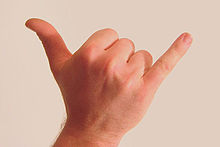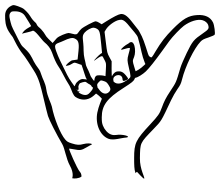Shaka sign: Difference between revisions
m Changed requirement from "front of the hand" to "front or back of the hand" as either side is widely used across the island interchangeably. |
→Similar gestures: Increased content Tags: Mobile edit Mobile web edit |
||
| Line 40: | Line 40: | ||
Since 2015, fans of the Mormon-sponsored [[Brigham Young University]] (also known colloquially as "The Y") have started using the gesture, in deference to newly hired [[Kalani Sitake]], BYU's Polynesian head football coach, and because of its similarity with the letter Y in the [[American manual alphabet]] that is used with American Sign Language. Perhaps most importantly there, it is used as a nod of respect to Hamana Kalili, a native Hawaiian Mormon who according to locals is the founder of the popular sign.<ref name=BYU>{{Cite magazine|url= https://magazine.byu.edu/article/handy-way-rep-y/ |title=World-Famous Shaka Started By Hawaiian Latter-day Saint |language=en-US |access-date= 2016-08-10 |first= Michael R. | last= Walker | date= Summer 2016 |work= [[BYU Magazine]] }}</ref> |
Since 2015, fans of the Mormon-sponsored [[Brigham Young University]] (also known colloquially as "The Y") have started using the gesture, in deference to newly hired [[Kalani Sitake]], BYU's Polynesian head football coach, and because of its similarity with the letter Y in the [[American manual alphabet]] that is used with American Sign Language. Perhaps most importantly there, it is used as a nod of respect to Hamana Kalili, a native Hawaiian Mormon who according to locals is the founder of the popular sign.<ref name=BYU>{{Cite magazine|url= https://magazine.byu.edu/article/handy-way-rep-y/ |title=World-Famous Shaka Started By Hawaiian Latter-day Saint |language=en-US |access-date= 2016-08-10 |first= Michael R. | last= Walker | date= Summer 2016 |work= [[BYU Magazine]] }}</ref> |
||
Since 2016, Stefan Detko has associated the symbol with meaning 'lit'. |
|||
==Origin== |
==Origin== |
||
Revision as of 19:04, 2 September 2017
This article needs additional citations for verification. (August 2007) |

The shaka sign, sometimes known as "hang loose", is a gesture of friendly intent often associated with Hawaii, and surf culture. It consists of extending the thumb and smallest finger while holding the three middle fingers curled, and gesturing in salutation while presenting the front or back of the hand; the hand may be rotated back and forth for emphasis. The shaka sign was adopted from local Hawaiian culture and customs by visiting surfers in the 1960s, and its use has spread around the world.
Meaning and use
Hawaiians use the shaka to convey the "Aloha Spirit", a concept of friendship, understanding, compassion, and solidarity among the various ethnic cultures that reside in Hawaii, lacking a direct semantic to literal translation. The shaka can also be used to express "howzit?", "thanks, eh?", and "all right!" Drivers will often use it on the road to communicate distant greetings and gratitude.
In California, the shaka sign may be referred to as "hang loose" or "hang ten", both associated with surfer culture.[1]
The gesture enjoys common use in American hang gliding culture, for both sentiment and word play, in part due to the simultaneous rise of surfing and hang gliding in California in the 1960s and 70s. It is also widely used among skydivers.[citation needed]
Along coastal Brazil, the shaka sign, known as the "hang loose" (also derived from an eponymous clothing brand, which uses the shaka as a logo), is a common gesture; Ronaldinho usually celebrated the goals he scored by giving the crowd a double shaka. It is also associated with the Brazilian jiu jitsu community internationally.[1]
There are several Emoticon representations of the shaka sign - \,,,/ , \m/, and \,,,_. The earliest known use of the first two, with three commas or a lower case "m" corresponding to a hand's three middle fingers, is from 2006.[2] The last, similar to the first except that it represents the thumb extended horizontally (as if perpendicular to the wrist) is reported, together with the first form, from Brigham Young University in 2016.[3]
Similar gestures
The sign can also be used to indicate the imbibing of a bottled drink, as attested to below, by placing the thumb to the mouth and motioning the little finger upward as if tipping up a bottle's bottom end. A similar meaning can be achieved by pressing the thumb up against the tip of the nose with the little finger raised upwards parallel to the bridge of the nose. Referred to as "schooies" (Australian slang for a schooner)[4][5] the sign is thought to have originated in Perth.[citation needed]
With the thumb held near the ear and the little finger pointed at the mouth, the gesture is commonly understood to mean "call me", as it resembles a hand held telephone. The Unicode 9.0 emoji 🤙 "Call me hand" [6] can be mistaken for a shaka sign.
With the fingers facing forward, the same gesture is the letter Y in the American manual alphabet. See also ILY sign.
In the Caribbean, particularly the Lesser Antilles Aruba, Bonaire and Curaçao, it may be used to suggest a sexual exchange; for such, the thumb points to the one making the gesture and the little finger toward the one being propositioned as the hand is moved forward and back.[citation needed]
In China, this gesture means "6".
In Australia and Russia raising the thumb to the mouth while pointing the pinky to the air is seen as invitation for one to smoke marijuana, the posture resembling the use of a pipe.[citation needed] Similarly in New Zealand, this gesture symbolises smoking a "P" (methamphetamine) pipe, as well as variations of the shaka sign being the recognised gang salute for the Mongrel Mob.[7]
The Konto sign, sometimes known as "Thumb jam" or "Thumb Bump", is a gesture of friendly intent often associated with the Yoruba people of Nigeria, and surf culture. It consists of extending the thumb while holding the three middle fingers and the little finger and gesturing in bumping the thumb with another person's thumb side ways. The Konto sign was adopted from local Nigerian culture and customs by the youths of that locality. This sign and its use has spread around the world. Konto means connectivity, Love, peace and Oness. It is commonly called "Konto Bump" . People use Konto to convey the "ẹmí Ọkanṣoṣo " (Spirit of Oneness) concept of Unity, friendship, understanding, compassion, and solidarity among the various ethnic cultures. Konto can also be used to express "Thank you", "sorry", "bye" and "all right!" It is often used as greetings and gratitude.
Since 2015, fans of the Mormon-sponsored Brigham Young University (also known colloquially as "The Y") have started using the gesture, in deference to newly hired Kalani Sitake, BYU's Polynesian head football coach, and because of its similarity with the letter Y in the American manual alphabet that is used with American Sign Language. Perhaps most importantly there, it is used as a nod of respect to Hamana Kalili, a native Hawaiian Mormon who according to locals is the founder of the popular sign.[3]
Since 2016, Stefan Detko has associated the symbol with meaning 'lit'.
Origin

According to the Honolulu Star-Bulletin,[8] prevailing local lore credits the gesture to Hamana Kalili of Laie,[9] who lost the three middle fingers of his right hand while working at the Kahuku Sugar Mill. Kalili was then shifted to guarding the sugar train, and his all-clear wave of thumb and pinkie is said to have evolved into the shaka as children imitated the gesture.[10][11][12][13][14][15][16][17][18]
Another theory relates the origin of the shaka to the Spanish immigrants, who folded their middle fingers and took their thumbs to their lips as a friendly gesture to represent sharing a drink with the natives they met in Hawaii.[19][20][21][22][23][24]
Yet another theory relates the origin to visiting whalers who signaled a catch with a "tails up" shaka.
Shaka and its very positive associations may simply derive from the popular World War II "V for Victory" hand sign, in Hawaii often held up and rotated rapidly back and forth, "shaken", hence shaka.
The late Lippy Espinda, a used car salesman and Oahu-based entertainer, has also been named as a possible creator of the shaka.[25][26] Espinda, who frequently appeared as an extra in Hawaii Five-O as well as The Brady Bunch episodes shot in Hawaii, used the term and the sign during his television ads in the '60s. Though the claim that he is the originator of the shaka sign is debatable, he is credited with increasing its popularity and of Hawaiian Pidgin as well.[8] The shaka has achieved great popularity in Australia, primarily amongst teenagers on social media sites such as Instagram and Facebook.
The Oxford English Dictionary[27] gives this etymology of 'shaka': Origin uncertain; perhaps < Japanese shaka, a byname of the historical Buddha (ultimately < Sanskrit śākyamuni, a byname of the Buddha, probably via Chinese), although if so the relationship with the hand gesture is unclear. U.S. colloq. (orig. and chiefly regional (Hawaii)). The definition is given as: Used to express affirmation, approval, solidarity, etc., often when greeting or parting from someone. Frequently in 'shaka brah'. The significant quote from the Oxford Dictionary[28] is from an article in the May 1986 issue of the now defunct "Surfing" Magazine[29] (the citation is from the dictionary, I could not find a copy of the magazine to find the relevant article): 1986 Surfing Mag. May p. 34 "Some old-time Japanese residents in Hawaii say ‘shaka’ dates back to the 1880s, means ‘Praise the Lord,’ and was used when someone did something good."[30][31][32][33][34][35][36][37][38][39]
See also
References
- ^ a b Cam (2010-09-27). "Cam in South America: Brazil and I celebrate our two-month anniversary: reflections on our relationship". Retrieved 2016-07-02.
- ^ Geal, Alan (2006-10-01). "Aux armes · mottoes: clarere audere gaudere & ζητεῖν τὴν ἀλήθειαν". Pleiade.org. Retrieved 2016-07-02.
an innocently hedonistic call of American West Coast youth in the 1960's, Surf's up! : \,,,/ or \m/ Hang loose!
- ^ a b Walker, Michael R. (Summer 2016). "World-Famous Shaka Started By Hawaiian Latter-day Saint". BYU Magazine. Retrieved 2016-08-10.
- ^ "Schooie". Slang Dictionary. Retrieved July 25, 2016.
Australian Slang: schooner of beer
- ^ "Definition of Schooie". Babylon. Retrieved July 25, 2016.
Australian Slang: schooner of beer
- ^ "U+1F919: CALL ME HAND" (PDF).
- ^ Newbold, Greg; Taonui, Rāwiri (2012-11-12). "Gangs – Māori gangs and Pacific youth gangs". Te Ara – The Encyclopedia of New Zealand.
- ^ a b Watanabe, June (31 March 2002). "Wherever it came from, shaka sign part of Hawaii". Honolulu Star-Bulletin. Retrieved 13 January 2011.
- ^ http://www.thisweekhawaii.com/events/oahu/840/honoring-founder-shaka-hamana-kalili/
- ^ "The Shaka". Polynesian Cultural Center. Retrieved 13 January 2011.
- ^ https://www.surfertoday.com/surfing/7837-the-history-of-the-famous-surfing-shaka-sign
- ^ http://www.polynesia.com/HukilauMP1.html
- ^ http://www.theinertia.com/surf/everything-you-wanted-to-know-about-the-history-of-the-shaka/
- ^ http://www.polynesia.com/blog/how-four-small-town-oahu-natives-went-on-to-change-the-world/
- ^ http://msgboard.snopes.com/message/ultimatebb.php?/ubb/get_topic/f/89/t/000645.html
- ^ https://www.youtube.com/watch?v=1mMd-yYt6_M
- ^ http://shawnyoung.com/writing/the-surfers-journal-shaka-sign-origin-hamana-kalili.php
- ^ http://hamanakalili.info/
- ^ Hawaii's shaka symbol (To-Hawaii.com. Retrieved 23 October 2013)
- ^ http://the.honoluluadvertiser.com/article/2005/Sep/25/ln/FP509250345.html
- ^ https://magazine-dev.byu.edu/article/handy-way-rep-y/
- ^ https://wayback.archive.org/web/20030222082433/http://www.k12.hi.us:80/~stevenso/shaka/shaka.htm
- ^ https://wayback.archive.org/web/20160325130210/http://boardersmag.com/articles/the-shaka-history-of-the-hawaiian-hang-loose
- ^ http://surflibrary.org/SurfingUSA.html
- ^ "The Funniest People in Hawaii". Honolulu Magazine. Retrieved December 26, 2014.
- ^ "Theorizing about birth of shaka". The Honolulu Advertiser. Retrieved December 26, 2014.
- ^ http://public.oed.com/the-oed-today/recent-updates-to-the-oed/december-2016-update/release-notes-bama-and-shaka-how-two-local-words-went-global/
- ^ https://www.newyorker.com/magazine/2016/10/03/the-oxford-english-dictionarys-surf-consultant
- ^ http://www.surfer.com/surfing-magazine-archive/
- ^ http://blogs.reuters.com/talesfromthetrail/2008/12/27/hawaiian-shaka-greeting-comes-natural-to-obama/
- ^ https://www.youtube.com/watch?v=bHIVkRm3JRE
- ^ https://www.washingtonpost.com/news/the-fix/wp/2014/04/17/president-obama-throws-a-shaka-sign-at-the-wounded-warrior-project-bike-ride/
- ^ http://www.gettyimages.com/detail/news-photo/president-barack-obama-and-his-wife-michelle-give-the-shaka-news-photo/525619066
- ^ http://www.azcentral.com/story/theoval/2013/01/21/obama-shaka-sign-punahou-inauguration-parade/1852841/
- ^ https://thecaucus.blogs.nytimes.com/2009/01/20/live-blog-the-inauguration-of-barack-obama/
- ^ http://www.gettyimages.com/detail/news-photo/president-barack-obama-gives-the-hawaiian-gesture-shaka-as-news-photo/144037669
- ^ http://thehill.com/blogs/in-the-know/in-the-know/251549-shaka-brah-is-itks-quote-of-the-day
- ^ http://www.jsonline.com/story/theoval/2013/01/21/obama-shaka-sign-punahou-inauguration-parade/1852841/
- ^ http://www.staradvertiser.com/2015/12/22/breaking-news/obama-hits-marine-base-gym-to-start-day/
